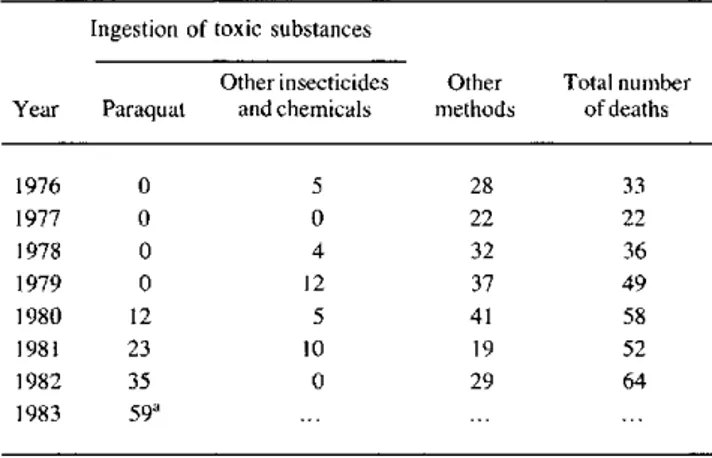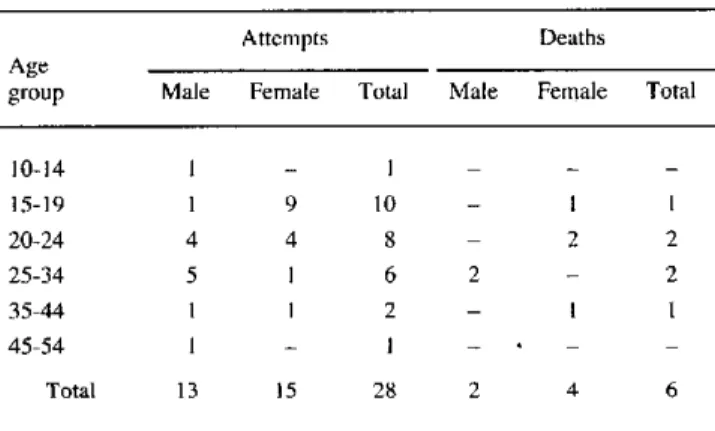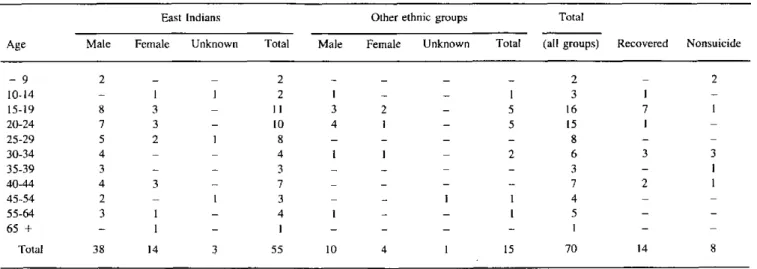rate of 35/100,000 could be achieved by 1986. The
reported 1983 rate of 27.5/100,000 is rapidly
approach-ing that prediction.
(Source: Walter Litven, Elen Smith and Patricia Milks, Non-Communicable Disease Division, Bureau of
Epidemiology, Health and Welfare Canada.)
Editorial Comment
The data presented underscore the importance of mortality statistics for the formulation and evaluation of health policies. They also serve as a reminder that gradual changes in mortality similar to those described for Canada can be expected over the medium and long term in the countries of Latin America and the Carib-bean, where health profiles are changing rapidly in the
same direction.
Health authorities in Suriname have maintained sur-veillance for suicide and have collected data for that cause of death since 1976. The number of deaths due to suicide by ingestion of agricultural insecticides and chemicals and other methods between 1976 and 1983 is shown in Table 1. Deaths due to the ingestion of the pesticide paraquat are also shown for 1980-1983. In recent years. a change has been observed in the methods used for suicide. Whereas before 1979 hang-ing and hang-ingestion of undiluted acetic acid were com-mon, the latter practically disappeared as a method of suicide after the Government banned the sale of undi-luted acetic acid. The impact of the ban can be seen
Table 1. Deaths by suicide due to poisoning and other methods in Suriname, from 1976 to 1983.
Ingestion of toxic substances
Other insecticides Other Total number Year Paraquat and chemicals methods of deaths
1976 0 5 28 33
1977 0 0 22 22
1978 0 4 32 36
1979 0 12 37 49
1980 12 5 41 58
1981 23 10 19 52
1982 35 0 29 64
1983 59
'Reports from two hospitals. ... Data not available.
'Based on a presentation to the CAREC Epidemiologists Meeting in June 1984, by Dr. Wim Bakker, Chief, Epidemiology Unit, Ministry of Health, Suriname.
in Figure 1. However, various toxic substances and chemical pesticides are readily available in stores, and they are commonly found in homes and on small farms throughout the country. A secondary effect of the ready availability of agricultural pesticides has been the in-creasing use of these substances for suicide (Table 1). In 1978, only 11% of the total number of suicidal deaths were due to toxic agricultural compounds, and three of the four deaths reported were accidental. By
Figure 1. Number of suicides in Suriname per quarter year, 1979-1981.
26
Ban on sale of
24 undiluted acetic acid
22
20
18
16
14
12
1
Suicide by ingestion of undiluted acetic acid
Suicide by other methods
TITDEXED
The Epidemiology of Suicide in Suriname1
1981 however, this proportion had risen to 63.5% and 23 out of 33 fatal poisonings were caused specifically by paraquat. Only two of those deaths were accidental.
The alarming increase in suicide by poisoning prompt-ed an intensification of the surveillance program for intoxications. Sentinel stations were established to re-port all such cases, and a specific questionnaire was introduced to collect data on paraquat intoxications. The ultimate purpose of the intensified surveillance program was to collect the information necessary for the development of regulations on the distribution and use of toxic agricultural products.
Table 2 and 3 summarize the results of intoxication surveillance at the Nickerie Hospital in 1983. This hospital serves a population of about 30,000 persons, most of them of East Indian origin. In 1983, of a total of 35 cases of intoxication treated at the hospital, 28 were attempted suicides. Six of the attempts resulted in death. Among the six persons who successfully com-mitted suicide, four were females (three housewives and one schoolgirl). Table 3 reveals that almost 70% of the patients who attempted suicide by poisoning were younger than 25 years of age. The male-to-female ratio in this youngest age group was 1:2. Herbicides
Table 2. Cases treated for intoxications at Nickerie Hospital, 1983.
Incidents Cases Deaths
Suicidal intoxications 28 6
Accidental intoxications 5
Homicidal intoxications 2 1
Total 35 7
Table 3. Attempted and successful suicides seen in Nickerie Hospital, by sex and age, 1983.
Attempts Deaths
Age
group Male Female Total Male Female Total
10-14 1 - - -
-15-19 1 9 10 - I 1
20-24 4 4 8 - 2 2
25-34 5 1 6 2 - 2
35-44 1 1 2 - I 1
45-54 1 - I - -
-Total 13 15 28 2 4 6
and pesticides used in 18 of the 28 suicide attempts included paraquat, endrine, azodrine, and other sub-stances.
In January 1984, intoxication surveillance was ex-tended to the Academic Hospitali of Paramaribo. As Table 4 shows, between 1 January and 17 May 1984 a total of 140 patients were treated in the emergency ward for intoxications. Thirty-six, or 25.7% of these patients had ingested paraquat. Because of lack of in-formation on 29 patients who were hospitalized during this period, and on the nature of their intoxication (whether suicidal, accidental, or homicidal), a retro-spective study of the records of the Academic Hospital was performed for the year 1983. The records of 70 patients admitted to the hospital for paraquat poisoning were reviewed (Table 5). Of these, 56 (80%) had died and 14 had recovered. Table 5 also reveals that the number of patients seen for this problem had doubled in the second half of 1983. Accidental paraquat poison-ings accounted for six cases, and one of them had died. Again half of the total number of patients were younger than 25 years of age. Table 6 shows the age and ethnic composition of the 70 patients hospitalized for paraquat intoxication. Fifty-five (79%) of the patients were of
Table 4. Cases of intoxications treated at the Emergency Ward of the Academic Hospital, Paramaribo, 1 January
to 17 May, 1984 (per month).
Month All cases Paraquat
January 68 12
February 35 12
March 13 5
April 14 5
May 1-17 10 2
Total 140 36
Table 5. Outcome for hospitalized cases of paraquat intoxication, Academic Hospital, Paramaribo, 1983,
by sex and ethnic group.
Period Deaths Recoveries Total
Firsthalf, 1983 19 5 24
Secondhalf, 1983 37 9 46
Total year 56 (80%) 4 (20%) 70
Male 48 (69%)
Female 18 (26%) Sex unknown 4 ( 6%)
East Indians 55 (79%) Other ethnic groups 15 (21%)
.
o
Table 6. Number of patients with paraquat intoxication treated at the Academic Hospital, Paramaribo, 1983, by age, sex, and ethnic group.
East Indians Other ethnic groups Total
Age Male Female Unknown Total Male Female Unknown Total (all groups) Recovered Nonsuicide
-9 2 - 2 - - - - 2 2
10-14 - I 1 2 1 - - 1 3 1
-15-19 8 3 - 1 3 2 - 5 16 7 1
20-24 7 3 - 10 4 1 - 5 15 1
-25-29 5 2 1 8 - - - - 8 -
-30-34 4 - - 4 1 1 2 6 3 3
35-39 3 - - 3 - - - 3
-40-44 4 3 - 7 - - - 7 2 1
45-54 2 - 1 3 -1 1 4 -
-55-64 3 1 - 4 1 - - 5
-65 + - 1 - I . I -
-Total 38 14 3 55 10 4 1 15 70 14 8
East Indian origin. The reasons for the reversal of the male-female ratio at this hospital compared to the Nickerie Hospital are unknown.
Discussion
The relatively sudden appearance in 1980 of paraquat as a major means of suicide in Suriname
coincides with its introduction and ready availability
throughout the country. At the moment, paraquat can be freely obtained. It can be found on the shelves of general stores, often next to groceries. It is frequently sold in soft drink and beer bottles. Moreover, bottles
and other containers of paraquat carry no labels with warnings or directions for its use. Sometimes these bottles are stored in refrigerators, and the contents are accidentally ingested when mistaken for beer and soft drinks. Suriname's previous experience with the ban on the sale of undiluted acetic acid demonstrates that the use of toxic substances for suicide can be controlled by vigorous regulation of the sale and distribution of those products. The data described here suggest that similar regulations should be instituted for the sale and use of agricultural pesticides.
(Source: Epidemiology Unit, PAHO.)
Calendar of Courses and Meetings
Takemi Fellowships in International Health
The Harvard School of Public Health announces its 1986-1987 fellowships for research and advanced train-ing on critical issues of international health, especially those relating to developing countries. Applicants must have completed graduate degrees and/or had some years of experience. They are expected to demonstrate strong interest in the issues central to the Program; potential leadership capacity in their home countries, and appropriate preparation (including facility in En-glish) to enable them to benefit from a period at Har-vard. Applicants may come from any relevant
disci-pline or profession (e.g. medicine, law, public health, economics, administration, and other social sciences).
Information is available from: Professor David E. Bell, Acting Director, Takemi Program in International Health, Harvard School of Public Health, 665 Hunt-ington Avenue, Building 1, Boston, Massachusetts 02115, U.S.A.
Summer Courses in Epidemiology in the United States
* The Johns Hopkins University School of Hygiene and Public Health will sponsor the fourth annual
13


